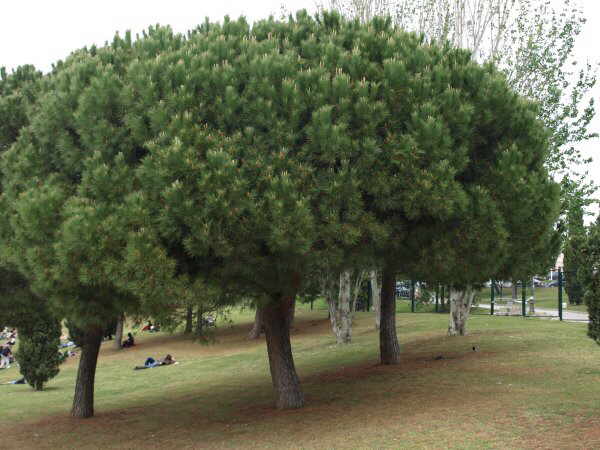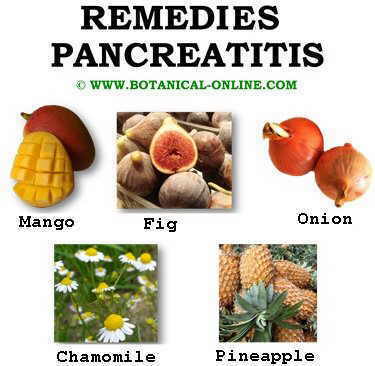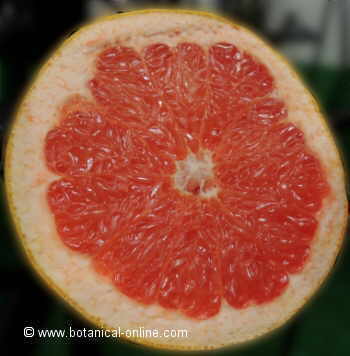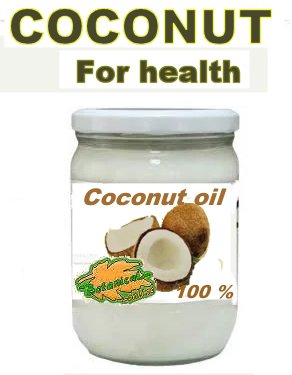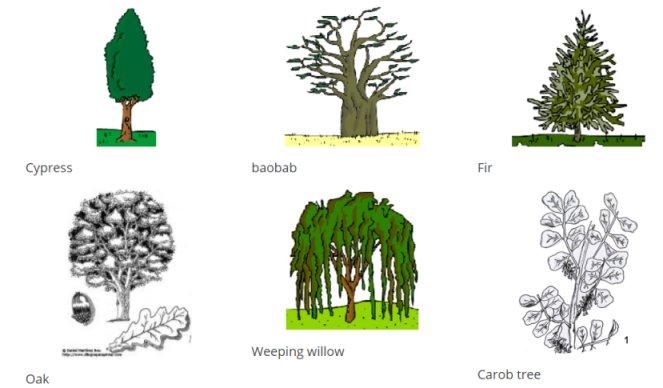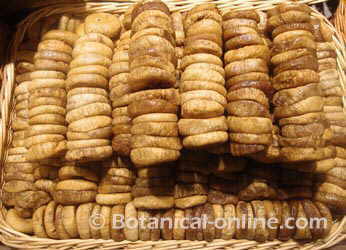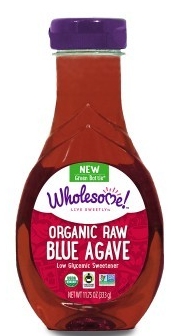Dry beans nutritional properties
What are dried beans?
From a dietary standpoint “dry beans” are the dry seeds of the bean plant (Phaseolus spp.) They are collected dry to eat.
Although all varieties of beans can be eaten tender, we must distinguish the “dry beans” varieties from varieties that are used to eat as “green beans” which are those that are used for consumption when the fruit is not ripe and we consume both, the pods and the seeds inside them. (More information about green beans properties in the listing below)
Because of their properties and their characteristics, dry beans can not be included in the vegetable food group but within the legumes
IMPORTANCE OF DRY BEANS AS FOOD
Dry beans are rich in proteins and nucleic acids.
Although green beans contain proteins, the main virtue of dried beans compared with green beans is their higher richness in proteins. As shown in the table below, dried beans contain almost four times more protein than green beans and they are also much richer in nucleic acids.
- It has been demonstrated the importance of nucleic acids in the cell renewal process, so eating dry beans is a good way to activate the body and keep it strong and youthful for longer.
Proteins are compounds formed by blocks of amino acids that are essential in many processes in the body but, above all, they are the body builders since they form and maintain the body cells. It is known that, discarding the water our organism contains, more than half of the resultant total weight is made proteins. For example, keratin is a protein that forms nails, hair or the outer skin. collagen is another protein involved in the formation of cartilage, bones, tendons and skin.
Besides being the building blocks of the body, proteins play other roles in the body such to take part in the metabolism of our body because they make hormones or enzymes. They also protect the body against attack by microorganisms since antibodies are composed of proteins.
There are different types of dry beans, with different colors, textures, etc. More information
Proteins are responsible for other processes such as muscle contraction, which occurs by the action of a protein called myosin, or the transport of oxygen to all parts of the body being 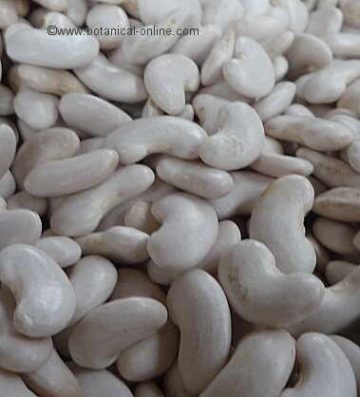 conducted through a protein called hemoglobin.
conducted through a protein called hemoglobin.
The human body needs proteins because, unlike plants, they can not be synthesized and must be taken by means eating foods from plants or animals. Animals obtain proteins by eating the plants containing these principles.
Higher quality proteins are those containing eight essential amino acids (leucine, methionine, phenylalanine, threonine, tryptophan, valine, isoleucine and lysine). Humans must eat protein in their diet to prevent malnutrition and the occurrence of many diseases.
Foods rich in high quality proteins, that’s to say, those containing all essential amino acids, are foods of animal origin. However, animal foods have potential complications because of the presence of saturated fat and cholesterol that can favor the appearance of numerous cardiovascular diseases. A lacto-ovo vegetarian, based on plant foods and supplemented with eggs and milk can provide the necessary proteins with all essential amino acids.
Among the protein-rich foods we must include legumes, among them we must take into account dry beans.
Dry beans are a much more caloric food than green beans
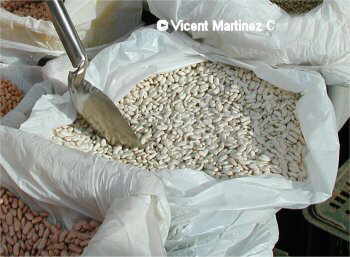 Photo of dry beans
Photo of dry beans
Dried beans contain ten times more calories than green beans. Dried beans calories come from its richness in carbohydrates, which represent more than half of its weight. This allows this food to provide a lot of energy, which is particularly necessary when a great physical effort is needed.
This fact implies that dried beans are not recommended for people who are on slimming diets or for people with obesity. This food is recommended for low-fat diets as they contain very little fat and all of it is unsaturated, so they are more advisable dietetically than other foods from animal origin. (meat, milk, etc)
In addition to their low fat content, dry beans provide complex sugars that are dumped into the bloodstream gradually, thus satisfying the body much longer, helping to stave off hunger. This allows us to avoid eating other less desirable more caloric foods. Dry beans can be included in the diet to prevent craving for food.
Being low in sodium and high in potassium is equally useful for those on low sodium diets or those who want to alleviate fluid retention problems.
Dry beans are richer in fiber than green beans
Dried beans contain much more fiber than green beans. Fiber is especially useful in treating diabetes and cholesterol. In both cases, fiber is able to reduce the intestinal absorption of cholesterol and sugar in the intestine so it is helpful for the treatment of these diseases.
Dry beans richness in fiber is another important factor when it comes to whet the appetite.
Fiber helps improve intestinal transit by increasing stool bulk which promotes peristalsis or movement of the bowel wall. Therefore, dry beans help prevent or treat constipation.
We must not forget the importance of this component in the prevention of colon cancer, because fiber has the ability to wrap in faeces heavy metals and other toxic chemicals which, if deposited on the intestinal walls, they would represent a potential threat to this part of the body.
Fiber content, along with vitamin A, vitamin B and folic acid, advise regular consumption of dry beans as a way to prevent the development of cancerous tumors in the colon.
NUTRITIONAL VALUE OF BEANS
| Composition of green beans and dry beans per 100 g | ||
| Green beans raw | Dry navy beans raw | |
| Water | 90, 27 g | 12, 36 g |
| Calories | 31 Kcal | 335 Kcal |
| Fat | 0,12 g | 1, 28 g |
| Proteins | 1, 8 g | 22,3 g |
| Carbohydrates | 7, 14 g | 60, 65 g |
| Fiber | 3, 4 g | 24, 4 g |
| Potassium | 209 mg | 1140 mg |
| Sodium | 6 mg | 14 mg |
| Phosphorus | 38 mg | 443 mg |
| Calcium | 37 mg | 155 mg |
| Copper | 0,069 mg | 0, 879 mg |
| Magnesium | 25 mg | 173 mg |
| Manganese | 0, 214 mg | 1, 309 mg |
| Iron | 1,04 mg | 6, 44 mg |
| Zinc | 0,24 mg | 2, 54 mg |
| selenium | 0,6 mg | 11 mg |
| Vitamin C | 16, 3 mg | 3 mg |
| Vitamin B1 (Thiamin) | 0, 084 mg | 0, 645 mg |
| Vitamin B2 (Riboflavin) | 0, 105 mg | 0, 232 mg |
| Vitamin B3 (Niacin) | 0,75 mg | 2, 063 mg |
| Vitamin B9 (Folacin) | 37 mcg | 370 mcg |
| Vitamin B6 (Pyridoxine) | 0, 074 mg | 0, 437 mg |
| Vitamin A | 668 IU | 4 IU |
| Vitamin E | 0, 410 mg | 0, 440 mg |
Dry beans are a good food for circulation, for pregnant women and for people with problems in absorbing food
Dry beans are much richer than green beans in some minerals. They are especially rich in magnesium and potassium, both involved in lowering blood pressure. consequently, these minerals along with folic acid, riboflavin, and vegetable fiber also improve health by means of preventing cardiovascular accidents.
Dried beans are much richer in folate than green beans, so they are especially recommended for pregnancy or breastfeeding diet. Part of this vitamin is transferred to the fetus or baby. Folic acid can prevent malformation or improper growth in the baby. Also, it might be interesting for people with frequent diarrhea (Crohn’s disease, ulcerative colitis or similar) because these patients often have folate deficiencies as they have poor absorption of this vitamin.
Dried beans are less antioxidant than green beans
Dried beans contain less vitamin C than green beans. The functions of this vitamin are vast, but a major one is its ability to neutralize free radicals. This antioxidant helps the body to eliminate the negative effect of free radicals, preventing cellular aging and the onset of many degenerative diseases.
Dried beans contain much less amount of vitamin A, that green beans. Vitamin A is another antioxidant that plays a very important role in the health of the skin, eyes or in the control of development of cancer cells.
Dry beans are not recommended for some people
Some people have trouble when digesting dried beans, causing indigestion problems with occurrence of flatulence, heartburn, stomach ache and other digestive anomalies.
It has been found that regular consumption of this food aids these symptoms to disappear gradually. Furthermore, to avoid these problems, it is useful to soak dry beans in hot water for four or five hours. Subsequently, first boiling water must be removed and new water must be added to simmer for at least an hour.
If you prefer, you can buy dried beans previously boiled fresh or previously canned, the first being more desirable than those sold canned that generally contain a lot of preservatives and a too high amount of salt.
![]() More information on beans.
More information on beans.


